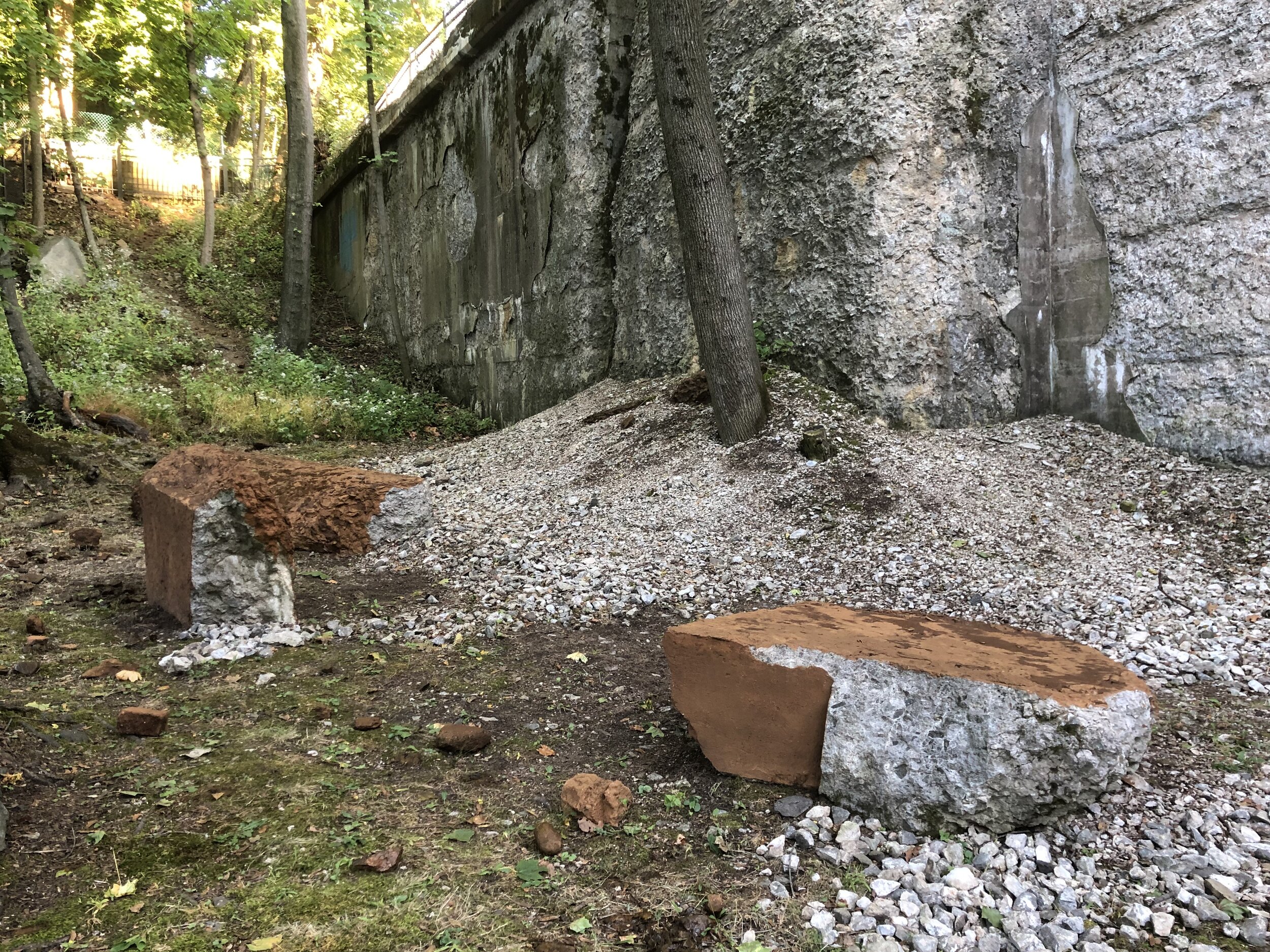Concrete Regolith (Highbrook)
at Highbrook Sculpture Garden, Pelham NY
Iron oxide (iii) and water from High Brook, organic pigment binder, architectural fragments from the Highbrook Highline Bridge, Pelham, NY
2019
I stained fragments of the Historic cast concrete Highbrook Bridge with iron oxide(iii) I collected from a small pool at the side of the bridge, the only visual evidence of the brook that lends its name to the bridge, sculpture garden, and street below. The brook has otherwise been buried below the surrounding constructed environment.
The Highbrook Sculpture Garden is a perfectly peculiar plot of land adjacent the Highbrook Highline Bridge, a site on the National Register of Historic Places. When invited to do a project in the Sculpture Garden, I became interested in the history of the site—the bridge as an artifact of early 20th century railroad architecture, the materials technology of a single arch cast concrete bridge, the rapid movement of bodies on a modern electric railroad, and the transition of the surrounding area from woodland to village. But as I explored the surrounding spaces considering that last point of how the bridge construction initiated a larger transition in the landscape, I became intrigued by a different kind of motion, the processes involved in the natural and geological history underlying—and entangled with—the human history.
I see the entropic forces of wind, water, acids playing into the weathered, crumbling textures of the concrete, and the fabric re-enforced skins of the cast concrete peeling away from the structure. The human ordering impulse is coming undone in conglomerate artifacts scattered over the ground. I experience the decaying bridge as a body among other material bodies undergoing changes—organic bodies of Maple trees, grey squirrels, grass spiders, as well as the mineral bodies of exposed bedrock and pyrite, and also the body for which the bridge, the studios and garden, and the adjacent street are named: the Highbrook, a body of water.
The Brook is located up the hill from the street, running underground, at the side of the overpass. It makes itself known, through subtle sounds, through the green plant life it supports, and especially through its color; the Brook contains iron oxide that appears rusty red in the water when it comes into contact with oxygen at the surface. The Brook is a vibrant body that persists, a lively, vital ‘bleeding’ at the top side of the architectural ruin.
I gathered the iron oxide (iii) where it collects on decaying organic matter in the small red pool of the Brooke on the overpass, and used it as a pigment mixed with wheat paste to make a stain. I applied the earthy stain to the surfaces of chunks of the bridge that have fallen to the ground, and re-arranged the smaller pieces of fallen concrete to suggest a downward and outward motion underlying the return of the concrete’s rock and sand sediment from the bridge to the earth.
These actions are ritual gestures, honoring a persistent vitality in the earth that works through forces of accumulation and decay, and occurs in cycles. Cyclical time acknowledges agency in the earth’s processes and does not see time as a line measuring points of human progress at the earth’s surface, in the regolith. The word regolith combines two Greek words meaning “rock” and “blanket”, and refers to the heterogenous layer of loose material at the earth’s surface, like dust, soil, and bits of rock, which cover solid rock underneath. In the age of the Anthropocene the earth’s regolith is comprised not only of organic matter and mineral sediment, but also to a great extent the sediment of human-processed materials, like concrete. The concrete regolith is material transitioning, and the iron oxide pigment is a visual and material summons to the viewer to experience a sense of place through the natural history and processes that underlie and re-assimilate the concrete artifacts of human striving.







